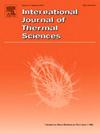光热应用中近红外窗口中金纳米棒和球的等离子体加热和光学响应
IF 4.9
2区 工程技术
Q1 ENGINEERING, MECHANICAL
International Journal of Thermal Sciences
Pub Date : 2025-05-24
DOI:10.1016/j.ijthermalsci.2025.110021
引用次数: 0
摘要
本研究通过改变金纳米棒(aunr)和长形金纳米球(ausp)的长径比(η),在保持固定粒径为10 nm的情况下,研究了它们的热光学性质。将极化角(θ)调节在0°~ 90°之间,采用有限元法(FEM)模拟分析了水介质中的电势分布、介电常数和吸收特性。这两种纳米结构由于其纵向和横向等离子体模式而表现出近红外(NIR)等离子体共振。增大η可使aunr的等离子体共振从670 nm红移至1230 nm, ausp的等离子体共振从600 nm红移至1045 nm。两种金纳米粒子(AuNP)纳米结构在可见光谱中均表现出固定的横向模式峰,而在近红外区域的纵向模式峰则随长径比的变化而变化。吸收截面分析显示了极化相关位移,在相同条件下,aunr在90°处经历蓝移,而ausp的吸收效率较低。η变化时的最高内部温度为0.66 ~ 8.13°C, θ变化时的最高内部温度为0.58 ~ 7.91°C。相比之下,对于长形ausp, η变化的温度范围为0.17 ~ 2.92℃,θ变化的温度范围为0.23 ~ 3.26℃。脉冲光照产生的温度明显高于连续光照,aunr和ausp分别升高近10倍和4倍。这些发现证明了AuNR和AuSP纳米结构的热等离子体潜力,并强调了连续波和fs脉冲加热在等离子体应用中的互补作用,强调了它们在生物医学和纳米光子技术中的局部热能转换的适用性。本文章由计算机程序翻译,如有差异,请以英文原文为准。
Plasmonic heating and optical response of Au nanorods and spheroids in the NIR window for photothermal applications
This study examines the thermo-optical properties of Au nanorods (AuNRs) and prolate gold nanospheroids (AuSPs) by varying their aspect ratio (η) while maintaining a fixed particle diameter of 10 nm. The polarization angle (θ) was adjusted between 0° and 90°, and simulations were performed using the Finite Element Method (FEM) to analyze the electric potential distribution, dielectric permittivity, and absorption characteristics in an aqueous medium. Both nanostructures exhibit near-infrared (NIR) plasmonic resonance due to their longitudinal and transverse plasmon modes. Increasing η redshifts the plasmonic resonance from 670 to 1230 nm for AuNRs and from 600 to 1045 nm for AuSPs. Both gold nanoparticle (AuNP) nanostructures exhibit a fixed transverse mode peak in the visible spectrum due to constant particle diameter, while the longitudinal mode peak in the NIR region shifts with aspect ratio variations. The absorption cross-section analysis showed polarization-dependent shifts, with AuNRs experiencing a blueshift at 90° and AuSPs demonstrating lower absorption efficiency under the same conditions. The maximum internal temperature of AuNRs ranged from 0.66 °C to 8.13 °C for η variations and from 0.58 °C to 7.91 °C for θ variations. In comparison, for prolate AuSPs, the temperature ranged from 0.17 °C to 2.92 °C for η variations and from 0.23 °C to 3.26 °C for θ variations. Pulsed illumination generated significantly higher temperatures than CW, with nearly tenfold and fourfold increases for AuNRs and AuSPs, respectively. These findings demonstrate the thermoplasmonic potential of AuNR and AuSP nanostructures and highlight the complementary roles of CW and fs-pulsed heating in plasmonic applications, emphasizing their suitability for localized thermal energy conversion in biomedical and nanophotonic technologies.
求助全文
通过发布文献求助,成功后即可免费获取论文全文。
去求助
来源期刊

International Journal of Thermal Sciences
工程技术-工程:机械
CiteScore
8.10
自引率
11.10%
发文量
531
审稿时长
55 days
期刊介绍:
The International Journal of Thermal Sciences is a journal devoted to the publication of fundamental studies on the physics of transfer processes in general, with an emphasis on thermal aspects and also applied research on various processes, energy systems and the environment. Articles are published in English and French, and are subject to peer review.
The fundamental subjects considered within the scope of the journal are:
* Heat and relevant mass transfer at all scales (nano, micro and macro) and in all types of material (heterogeneous, composites, biological,...) and fluid flow
* Forced, natural or mixed convection in reactive or non-reactive media
* Single or multi–phase fluid flow with or without phase change
* Near–and far–field radiative heat transfer
* Combined modes of heat transfer in complex systems (for example, plasmas, biological, geological,...)
* Multiscale modelling
The applied research topics include:
* Heat exchangers, heat pipes, cooling processes
* Transport phenomena taking place in industrial processes (chemical, food and agricultural, metallurgical, space and aeronautical, automobile industries)
* Nano–and micro–technology for energy, space, biosystems and devices
* Heat transport analysis in advanced systems
* Impact of energy–related processes on environment, and emerging energy systems
The study of thermophysical properties of materials and fluids, thermal measurement techniques, inverse methods, and the developments of experimental methods are within the scope of the International Journal of Thermal Sciences which also covers the modelling, and numerical methods applied to thermal transfer.
 求助内容:
求助内容: 应助结果提醒方式:
应助结果提醒方式:


